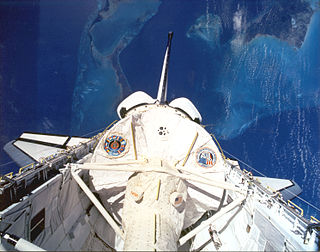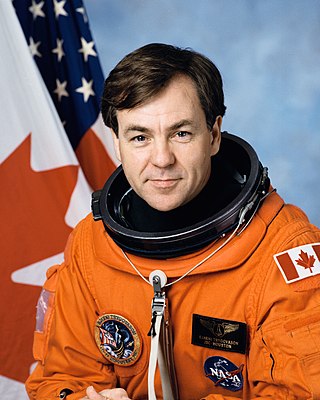
STS-50 was a NASA Space Shuttle mission, the 12th mission of the Columbia orbiter. Columbia landed at Kennedy Space Center for the first time ever due to bad weather at Edwards Air Force Base caused by the remnants of Hurricane Darby.

Robert Brent "Bob" Thirsk, is a Canadian engineer and physician, and a former Canadian Space Agency astronaut. He holds the Canadian record for the most time spent in space. He became an officer of the Order of Canada (OC) in 2013 and was named to the Order of British Columbia (OBC) in 2012.

James Donald Halsell Jr. is a retired United States Air Force officer, a former NASA astronaut. The veteran of five Space Shuttle missions pled guilty in 2021 to two counts of manslaughter and two counts of assault as a result of a motor vehicle accident in 2016. As of May 2021, he is incarcerated in Alabama.

The University of Alabama at Birmingham (UAB) is a public research university in Birmingham, Alabama. Founded in 1969 in the University of Alabama System, UAB has grown to be the state's largest single employer, with more than 24,200 faculty and staff and over 53,000 jobs at the university and in the health system. The university is classified among "R1: Doctoral Universities – Very high research activity".

Bjarni Valdimar Tryggvason was an Icelandic-born Canadian engineer and a NRC/CSA astronaut. He served as a Payload Specialist on Space Shuttle mission STS-85 in 1997, a 12-day mission to study changes in the Earth's atmosphere.

Dafydd Rhys Williams OC OOnt CCFP FCFP FRCPC FRCP FRCGS is a Canadian physician, public speaker, CEO, author and a retired CSA astronaut. Williams was a mission specialist on two Space Shuttle missions. His first spaceflight, STS-90 in 1998, was a 16-day mission aboard Space Shuttle Columbia dedicated to neuroscience research. His second flight, STS-118 in August 2007, was flown by Space Shuttle Endeavour to the International Space Station. During that mission he performed three spacewalks, becoming the third Canadian to perform a spacewalk and setting a Canadian record for total number of spacewalks. These spacewalks combined for a total duration of 17 hours and 47 minutes.

Norman Earl Thagard, M.D., is an American scientist and former U.S. Marine Corps officer and naval aviator and NASA astronaut. He is the first American to ride to space on board a Russian vehicle, and can be considered the first American cosmonaut. He did this on March 14, 1995, in the Soyuz TM-21 spacecraft for the Russian Mir-18 mission.

Owen Kay Garriott was an American electrical engineer and NASA astronaut, who spent 60 days aboard the Skylab space station in 1973 during the Skylab 3 mission, and 10 days aboard Spacelab-1 on a Space Shuttle mission in 1983.

Roger Keith Crouch is an American scientist and astronaut who flew as a payload specialist on two NASA Space Shuttle missions in 1997.

Bonnie Jeanne Dunbar is an American engineer and retired NASA astronaut. She flew on five Space Shuttle missions between 1985 and 1998, including two dockings with the Mir space station.

Charles Donald "Sam" Gemar is an American former astronaut with NASA and a lieutenant colonel in the United States Army. Gemar has flown on three Space Shuttle missions. Gemar has completed 385 orbits of the Earth and over 581 hours in space. He has also served in different positions in NASA, including as a CAPCOM for Shuttle missions. Gemar was the first astronaut to be born in the state of South Dakota.

Richard Michael Linnehan is a United States Army veterinarian and a NASA astronaut.

Fred Weldon Leslie is an American scientist who flew on the NASA STS-73 Space Shuttle mission as a payload specialist.

Chiaki Mukai is a Japanese physician and JAXA astronaut. She was the first Japanese woman in space, the first Japanese citizen to have two spaceflights, and the first Asian woman in space. Both were Space Shuttle missions; her first was STS-65 aboard Space Shuttle Columbia in July 1994, which was a Spacelab mission. Her second spaceflight was STS-95 aboard Space Shuttle Discovery in 1998. In total she has spent 23 days in space.

Basil Isaac Hirschowitz was an academic gastroenterologist from the University of Alabama at Birmingham (UAB) best known in the field for having invented an improved optical fiber which allowed the creation of a useful flexible endoscope. This invention revolutionized the practice of gastroenterology and also was a key invention in optical fiber communication in multiple industries.

Kathryn Ryan Cordell Thornton is an American scientist and a former NASA astronaut with over 975 hours in space, including 21 hours of extravehicular activity. She was the associate dean for graduate programs at the University of Virginia School of Engineering and Applied Science, currently a professor of mechanical and aerospace engineering.

Donald Alan Thomas, Ph.D. is an American engineer and a former NASA astronaut.

Tara Melaine Ruttley is Associate Chief Scientist for Microgravity Research at NASA Headquarters in Washington, DC. Prior to this, she was Associate Program Scientist for the International Space Station (ISS) at NASA's Johnson Space Center in Houston, Texas. Until 2007, she was lead hardware engineer for the ISS Health Maintenance System, leading a team of engineers whose job was to provide reliable medical equipment that kept astronauts healthy in orbit. She subsequently served as the lead hardware engineer for the ISS Human Research Facility. She served as an aquanaut on the NASA Extreme Environment Mission Operations 6 crew in July 2004.
Microgravity Experiment Research Locker/Incubator (MERLIN) was designed by University of Alabama at Birmingham (UAB) Center for Biophysical Sciences and Engineering (CBSE) to operate as a hardmounted, single middeck locker equivalent within the ISS EXPRESS rack, the Space Shuttle, SpaceX Dragon, and Cygnus (spacecraft). It is used to provide a temperature controlled environment for scientific experiments between -20 °C and 48.5 °C. MERLIN is also used to Support Crew Galley Operations.
GLACIER was designed and developed by University of Alabama at Birmingham (UAB) Center for Biophysical Sciences and Engineering (CBSE) for NASA Cold Stowage. Glacier was originally designed for use on board the Space Shuttle, but is now used for storing scientific samples on ISS in the EXpedite the PRocessing of Experiments to Space Station (EXPRESS) rack, and transporting samples to/from orbit via the SpaceX Dragon or Cygnus spacecraft. GLACIER is a double middeck locker equivalent payload designed to provide thermal control between +4 °C and -160 °C.




















